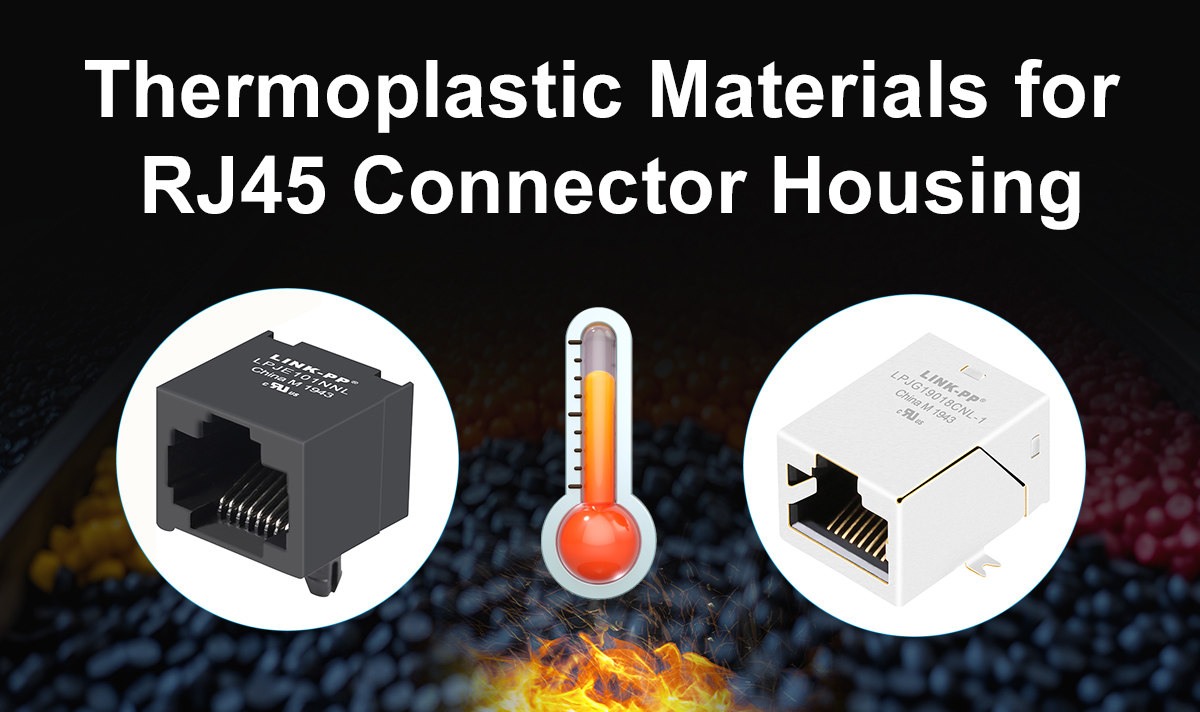
As Ethernet-based applications evolve to meet the demands of higher speeds, tighter integration, and harsher environments, RJ45 connectors must offer more than just electrical connectivity—they must also withstand thermal, mechanical, and chemical stress. One key factor behind this resilience is the choice of housing material, especially in high-temperature applications such as reflow soldering, industrial automation, and automotive networking.
In this article, we’ll explore common high-temperature thermoplastic materials used for RJ45 connector housings, compare their properties, and provide guidance to engineers and buyers on making the right selection.
Key Requirements for RJ45 Housing Materials
High Heat Resistance – Often up to 260–265°C (for 5 seconds in reflow soldering)
Flame Retardant – UL94 V-0 certified
Dimensional Stability – Essential for tight pin alignment, especially in SMT designs
Good Moldability – For precision injection molding and volume production
RoHS/REACH Compliance
🔍 Note: Short-term heat resistance refers to soldering peak conditions (typically 5 seconds); it is not the same as long-term continuous use temperature (RTI).
Common High-Temperature Thermoplastics Used in RJ45 Housings
Materials | Full Name | Thermal Limit (Short-Term) | Applications | Key Properties |
|---|---|---|---|---|
PBT + GF | Polybutylene Terephthalate (Glass-Filled) | ~250–265°C | Through-hole, wave soldering | Cost-effective, high mechanical strength, UL94 V-0. Not suitable for reflow soldering. |
PA66 + GF | Nylon 66 (Glass-Filled) | ~240–250°C | Modular jacks | Tough and durable, but more moisture-sensitive. Needs moisture control before processing. |
LCP | Liquid Crystal Polymer | ~260°C+ | SMT RJ45, high-speed Ethernet | Superior dimensional precision, low warpage, fast mold cycle, fully reflow capable. |
PEEK | Polyether Ether Ketone | ~300°C | Extreme environments | Premium performance, high cost. Suitable for harsh conditions and long-term thermal loads. |
📌 Tip: Always distinguish between short-term soldering temperature limits and long-term service temperatures like RTI (Relative Thermal Index).
PBT vs LCP: Which to Use?
Property | PBT | LCP |
|---|---|---|
Cost | Low | Higher |
Soldering Compatibility | Wave soldering only (265°C/5 sec). Not for reflow. | Full reflow compatible (JEDEC J-STD-020) |
Dimensional Stability | Good | Excellent |
Best For | Standard RJ45, through-hole | SMT, multi-port, high-speed |
Real-World Examples from LINK-PP
1. LPJE101NNL
Housing & Insert Material: PBT, UL94 V-0
Soldering Capability: Wave soldering, 265°C for 5 seconds
Application: Through-hole magnetic RJ45 connector
2. LPJG19018CNL
Housing Material: Thermoplastic LCP
Application: SMT-compatible RJ45 connector, reflow soldering supported
🛠️ Custom Material Support
At LINK-PP, we understand that different industries—from telecom, automotive, to industrial controls—require specific material performance. That’s why we offer:
✅ Custom RJ45 connector housing materials
✅ Engineering support for thermal, flame-retardant, or chemical-resistant applications
✅ Tailored solutions for SMT, PoE, or high-frequency Ethernet designs
📩 Have a specific material requirement? Contact LINK-PP for custom options.
Final Takeaways
Choosing the right high-temperature thermoplastic for your RJ45 connector housing is essential for:
Ensuring compliance with UL, RoHS, and soldering standards
Achieving long-term reliability in high-heat, high-frequency environments
Supporting modern assembly processes like reflow soldering or wave soldering
🧠 Remember: Match your material not just to the temperature rating, but to your soldering process and mechanical tolerance needs.




